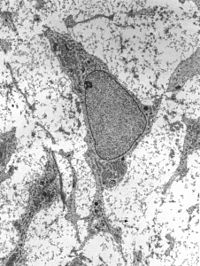
Photo from wikipedia
Patient‐specific induced pluripotent stem cells (iPSCs) are a promising source for cell transplantation therapy. In Parkinson's disease (PD) patients, however, their vulnerability and the transmission of pathological α‐Synuclein are possible… Click to show full abstract
Patient‐specific induced pluripotent stem cells (iPSCs) are a promising source for cell transplantation therapy. In Parkinson's disease (PD) patients, however, their vulnerability and the transmission of pathological α‐Synuclein are possible drawbacks that may prevent PD‐specific iPSCs (PDiPSCs) from being used in clinical settings. In this study, we generated iPSCs from idiopathic PD patients and found that there was no significant vulnerability between dopaminergic (DA) neurons generated from healthy individuals and idiopathic PD patients. PDiPSC‐derived DA neurons survived and functioned in the brains of PD model rats. In addition, in the brains of α‐Synuclein transgenic mice, PDiPSC‐derived DA neurons did not cause pathological α‐Synuclein accumulation in the host brain or in the grafts. These results suggested that iPSCs derived from idiopathic PD patients are feasible as donor cells for autologous transplantation to treat PD. © 2017 Wiley Periodicals, Inc.
Journal Title: Journal of Neuroscience Research
Year Published: 2017
Link to full text (if available)
Share on Social Media: Sign Up to like & get
recommendations!